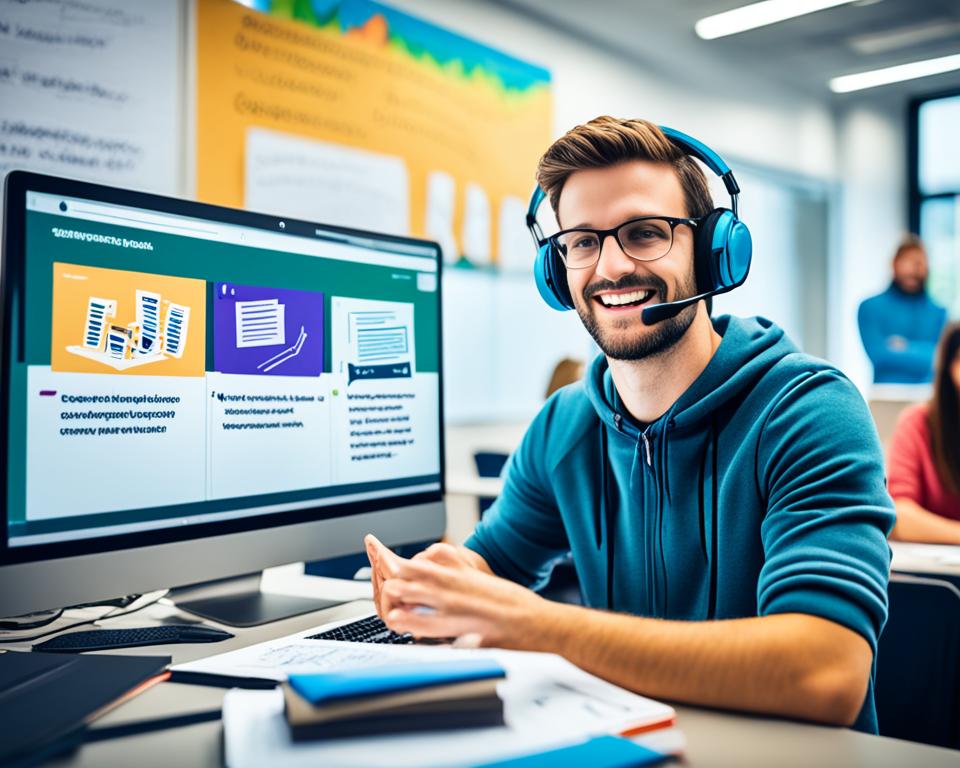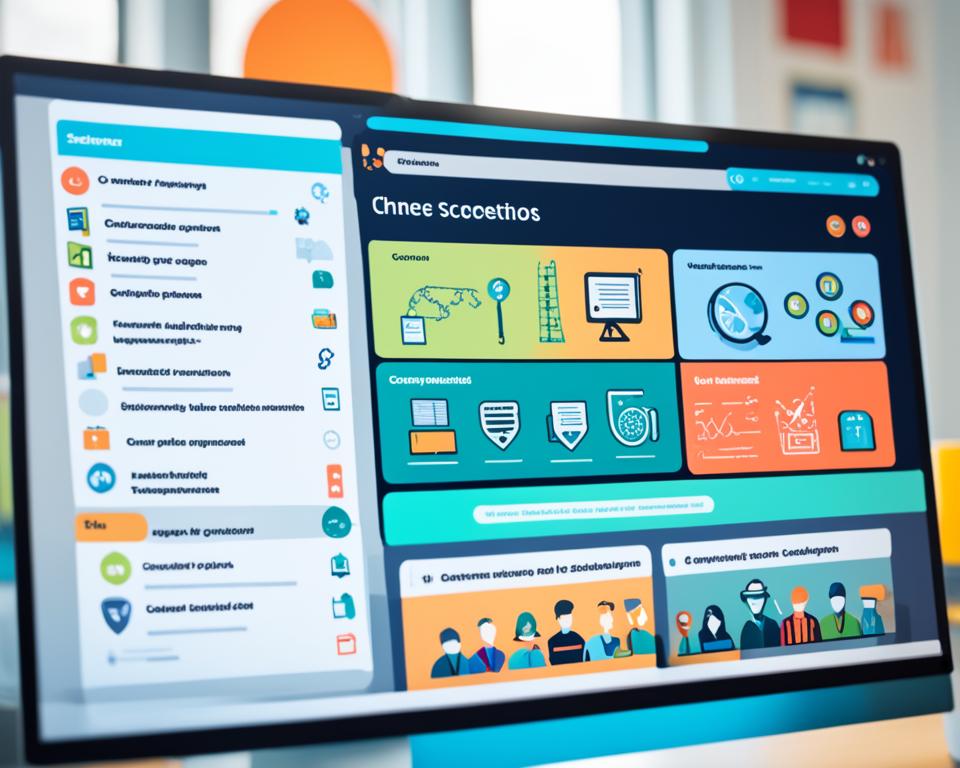As technology continues to permeate every aspect of our lives, the education sector has not been left untouched. The rise of online education has sparked a debate about its potential to replace traditional classroom learning in the future. With the increasing popularity of online learning platforms, virtual classrooms, and e-learning resources, it is important to explore the benefits and advantages of each method to understand the future of education.
Key Takeaways
- Online education and traditional classroom learning are two distinct approaches to education.
- Online education offers flexibility, accessibility, and a wide selection of programs.
- Traditional classroom learning provides social engagement and face-to-face interaction.
- The future of education lies in a blend of both methods, leveraging the advantages of each.
- Technology plays a crucial role in shaping the future of education, enabling personalized learning experiences.
The Flexibility of Online Education
Online education offers a high level of flexibility, benefiting both teachers and students. One of the key advantages is the ability to set and adjust one’s own learning pace. Unlike traditional classroom learning, where the pace is often predetermined, online learners have the freedom to progress through the material at a speed that suits their individual needs and abilities. This flexibility allows students to fully grasp concepts before moving on, ensuring a solid foundation of knowledge.
Moreover, online education provides the opportunity to create a personalized schedule that accommodates work-study balance. Many individuals pursuing higher education may have existing commitments like jobs or family responsibilities. With online learning, students have the autonomy to create a study schedule that fits into their daily routines, eliminating the need to sacrifice other aspects of their lives. This work-study balance contributes to reduced stress and enhances overall productivity.
Another aspect of flexibility in online education is the autonomy it offers in the learning process. Unlike traditional classroom settings, where students follow a structured curriculum, online learners have the freedom to explore topics of interest beyond the core syllabus. They can choose to delve deeper into specific subjects, conduct additional research, or access supplementary learning materials. This autonomy fosters a sense of ownership and empowers students to take control of their educational journey.
“The flexibility offered by online education allows me to set my own learning pace and manage my work-study balance effectively. I have the freedom to create a schedule that suits my needs and responsibilities, resulting in a more fulfilling learning experience.” – Jessica Davis, online learner
With the flexibility of online education, learners can shape their educational experience to suit their unique circumstances and goals. This freedom makes online education an attractive option for individuals seeking a flexible and self-directed approach to learning.
| Benefits of Online Education | Traditional Classroom Learning |
|---|---|
| Flexibility to set own learning pace | Rigid schedules and pace |
| Ability to create a personalized study schedule | Fixed class times |
| Autonomy in exploring additional topics | Structured curriculum |
By embracing the flexibility of online education, individuals can take charge of their learning journey, achieve a better work-study balance, and experience the benefits of autonomy in the learning process.
Wide Selection of Programs in Online Education
When it comes to online education, the possibilities are endless. The internet offers a wide selection of online programs tailored to various levels and disciplines. Whether you’re a student looking to pursue a specific field of study or a professional seeking to enhance your knowledge and skills, there are options for every type of learner.
Universities and higher education schools have recognized the growing demand for online education and are now offering online versions of their programs. This means that you can now access the same quality education and curriculum from the convenience of your own home or wherever you choose to study. The availability of online versions of university programs opens up a world of opportunities for students who may not have the means to physically attend a campus.
One of the key advantages of online education is the ability to obtain official certificates, diplomas, or degrees without being physically present on a university campus. Through accredited online programs, students can earn recognized credentials that hold the same value as those obtained through traditional classroom learning. These official certificates and degrees validate the knowledge and skills acquired through online education, making them a valuable asset in the professional world.
Whether you’re interested in pursuing a degree, obtaining a professional certificate, or simply gaining new knowledge and skills, online education provides a versatile platform with a wide range of programs to choose from. With the ability to study at your own pace and access materials from anywhere, online education offers flexibility and convenience that traditional classroom learning may not always provide.

Comparison of Online Programs
| Program | University | Duration | Flexibility |
|---|---|---|---|
| Bachelor of Science in Computer Science | Stanford University | 4 years | Flexible schedule |
| Master of Business Administration | Harvard Business School | 2 years | Part-time or full-time options |
| Professional Certificate in Digital Marketing | University of California, Berkeley | 6 months | Self-paced learning |
The table above provides a snapshot of the wide range of online programs available. From a Bachelor of Science in Computer Science at Stanford University to a Professional Certificate in Digital Marketing from the University of California, Berkeley, there are options for every interest and career path. The duration and flexibility of these programs vary, accommodating the needs of different types of learners.
With the wide selection of programs in online education, learners can find the perfect fit for their individual goals and aspirations. Whether you’re seeking a degree, a professional certificate, or simply expanding your knowledge, online education offers a world of opportunities at your fingertips.
Accessibility of Online Education
Online education provides unprecedented accessibility, allowing individuals to study or teach from anywhere in the world. The digital nature of online learning eliminates the need for physical commutes or rigid schedules, saving students and educators significant amounts of time and money.
With online education, students have the freedom to study at their own pace and create a learning schedule that suits their individual needs. This flexibility enables them to balance their studies with other commitments, such as work or family responsibilities.
Moreover, online education eliminates the geographical barriers that traditional classroom learning may present. Students can easily connect with prestigious universities or experienced instructors regardless of their location. This opens up a world of opportunities, fostering cross-cultural collaboration and collective learning.
“Online education has provided me with the incredible opportunity to pursue a degree while traveling the world. I can study and work on assignments from picturesque locations, combining my passion for learning and exploring new places.” – Sarah Thompson, online student
Travel enthusiasts can also take advantage of online education by studying while on the go. Whether it’s attending virtual lectures or completing assignments from a beachside paradise or a bustling café, the flexibility of online learning allows for a seamless integration of education into one’s travel adventures.
To illustrate the accessibility of online education further:
| Benefits of Online Education | Traditional Classroom Learning |
|---|---|
| No commutes or rigid schedules | Requires physical presence in a specific location at specific times |
| Savings in time and money | Costs associated with commuting, parking, and transportation |
| Opportunities for studying while traveling | Bound to a fixed classroom environment |
Through the accessibility of online education, individuals can overcome barriers and embrace a more flexible and convenient mode of learning. Whether they are pursuing higher education, expanding their skill set, or simply quenching their thirst for knowledge, online education opens doors and empowers lifelong learners.
Customized Learning Experience in Online Education
Online education offers a customized learning experience that caters to each student’s unique requirements and level of ability. Unlike traditional classroom settings, online learning provides flexibility in designing personalized learning paths. Students can select courses that align with their interests, enabling them to explore specific subjects in depth.
One of the major advantages of online education is the flexibility it offers for individual requirements. Students can learn at their own pace and at times that suit their schedules. They have the freedom to balance their studies with work, family commitments, or other personal responsibilities, making education accessible to a wider range of individuals.
In online education, class sizes are usually smaller, allowing for more personalized interaction with tutors or instructors. This fosters a supportive learning environment where students can ask questions, seek clarification, and engage in discussions with their educators. The smaller class sizes also make it easier for educators to provide greater interaction and feedback to each student, offering personalized guidance to enhance their learning journey.
Moreover, online education offers a wealth of diverse learning materials. From interactive videos and engaging multimedia content to digital textbooks and online resources, students have access to a wide range of educational materials that cater to different learning styles. This variety ensures that learners can engage with the content in ways that best suit their preferences and promotes a more comprehensive understanding of the subject matter.

By providing a customized learning experience, flexibility for individual requirements, smaller class sizes, greater interaction and feedback, as well as diverse learning materials, online education empowers students to take charge of their education and tailor their learning journey to suit their needs and interests.
Cost-Effectiveness of Online Education
Online education offers a cost-effective alternative to traditional classroom learning, making higher education more affordable and accessible for many individuals.
When compared to traditional classroom learning, online education often presents lower tuition fees and a variety of payment options. This affordability allows learners to pursue their academic goals without the financial burden that may come with attending a physical institution.
In addition to lower tuition fees, online education offers savings in other areas as well. One significant cost-saving advantage is the elimination of commuting expenses. With online education, learners can study from the comfort of their own homes, eliminating the need for expensive transportation or accommodation costs associated with attending a physical campus.
Furthermore, online learners often have access to digital course materials and resources, reducing or even eliminating the need to purchase textbooks and other physical materials. Many online courses offer digital materials for free or at a significantly reduced cost, further contributing to the cost-effectiveness of online education.
For those seeking additional financial support, scholarships specifically tailored for online studies are available. These scholarships enable students to pursue their educational goals without the financial strain commonly associated with higher education. Scholarships for online studies provide opportunities for individuals from various backgrounds to access quality education and advance their careers.
Overall, the cost-effectiveness of online education is a significant advantage for individuals looking to pursue higher education while managing their expenses and seeking affordable alternatives to traditional classroom learning.
The Limitations of Online Education
While online education offers numerous advantages, it is essential to recognize its limitations. The lack of face-to-face interaction is one of the primary challenges of online learning. Unlike traditional classroom settings, online education struggles to replicate the collaborative and dynamic environment that fosters meaningful connections between students and instructors.
The difficulty in replicating the classroom environment is another noteworthy limitation. In a physical classroom, students can engage in real-time discussions, ask immediate questions, and experience hands-on activities. These aspects are more challenging to achieve in an online setting where interactions are often limited to text-based discussions and pre-recorded lessons.
“Online learning lacks face-to-face interaction, making it challenging to replicate the collaborative environment of a traditional classroom.”
Social learning, which involves learning from peers through observation, discussion, and teamwork, presents yet another challenge. Online education may hinder the opportunities for spontaneous group collaborations, impromptu debates, and shared experiences that enhance the overall learning process.
However, it is crucial to acknowledge that online education providers are continually striving to address these limitations. Through innovative technologies and interactive platforms, efforts are being made to bridge the gap between online and traditional classroom learning.
Table: Comparison of Online Education and Traditional Classroom Learning
| Aspects | Online Education | Traditional Classroom Learning |
|---|---|---|
| Face-to-face Interaction | Challenging to replicate | Promotes immediate engagement |
| Classroom Environment | Difficulty in simulating | Offers hands-on experiences |
| Social Learning | Challenges in achieving spontaneity | Encourages collaborative interactions |
Despite these limitations, online education remains a valuable option for individuals seeking flexible and accessible learning opportunities. By understanding the challenges, both educators and learners can leverage the strengths of online education while finding innovative ways to mitigate its limitations.
The Future of Education – a Blend of Online and Traditional Learning
The future of education is on the horizon, and it is evident that a blend of online and traditional learning will shape the path ahead. By combining the strengths of both methods, we can compensate for the limitations of each and create a holistic approach to education. This blend envisions personalized and engaging classrooms that cater to the diverse needs of students, fostering a conducive learning environment.
Online education has revolutionized the way we learn by providing flexibility and accessibility. Students can access educational resources anytime, anywhere, and set their own pace of learning. The digital realm offers a wealth of multimedia materials and interactive platforms that make the learning experience more immersive and engaging.
However, online education alone cannot entirely replace the value of traditional classroom learning. There is an innate need for social interaction and face-to-face engagement that traditional classrooms offer. The collaborative nature of in-person learning fosters teamwork, communication skills, and the development of interpersonal relationships. It creates a dynamic environment that cannot be replicated in an online setting.
Therefore, the future of education lies in finding the perfect balance between online and traditional learning. By leveraging the advantages of each method, educators can deliver personalized and engaging classrooms that cater to individual learning styles. This blend creates a synergy that optimizes the benefits of both approaches.
“The blend of online and traditional learning is the key to preparing students for the future. It allows us to harness the power of technology while maintaining the essential human connection of classroom learning.” – Dr. Emily Roberts, Education Expert
One possible approach to achieving this blend is through a hybrid learning model. This model combines online modules with in-person sessions, creating a seamless learning experience. Students can engage in online activities, collaborate with peers, and access resources remotely. Simultaneously, they can also participate in traditional classroom sessions for discussions, hands-on activities, and practical learning.
Furthermore, incorporating innovative technology tools and interactive platforms in traditional classrooms can enhance student engagement and facilitate personalized learning. Integration of simulations, virtual reality, and augmented reality can create immersive educational experiences that cater to a variety of learning styles.
Advantages of a Blend of Online and Traditional Learning:
- Flexibility and accessibility of online learning
- Social interaction and face-to-face engagement of traditional classrooms
- Personalized learning experiences
- Collaborative and interactive classroom environments
- Enhanced student engagement through technology integration
To shape the future of education, it is essential for educators, policymakers, and institutions to embrace this blend of online and traditional learning. By recognizing the unique advantages of each method and compensating for their limitations, we can create a transformative educational experience that prepares students for the challenges of the modern world.
The Role of Technology in Education
Technology plays a crucial role in education, revolutionizing the way we access resources and enhancing personalized learning experiences. With the advancement of e-learning tools, education has become an equalizer, providing individuals from all walks of life with the opportunity to learn and grow, regardless of their location or social status. Through the integration of technology, education has become more inclusive and accessible than ever before.

Enhancing Access to Resources and Learning Opportunities
Technology has paved the way for limitless access to educational resources. Through online platforms and digital libraries, learners can explore a vast range of materials, from textbooks to scholarly articles, at their fingertips. This abundance of resources empowers students to delve deeper into subjects of interest and facilitates self-directed learning.
In addition, technology has democratized education by breaking down geographical barriers. Remote learning platforms enable students to access quality education regardless of their location. This is particularly valuable for individuals living in remote areas, where traditional educational opportunities may be limited. Technology has truly bridged the gap and provided equal opportunities for all learners.
Personalized Learning Experiences
One of the key advantages of incorporating technology in education is the ability to personalize the learning experience. E-learning tools and platforms offer adaptive learning solutions, tailoring content and resources to meet the unique needs and learning styles of individual students. This level of personalization fosters engagement, motivation, and better retention of information.
Interactive multimedia, such as videos, simulations, and gamification, make learning more engaging and enjoyable. These tools enable students to grasp complex concepts in a visual and interactive manner, facilitating deeper understanding and knowledge retention.
Empowering Students with Personalized Feedback
Technology also plays a significant role in providing students with personalized feedback, allowing them to monitor their progress and make data-driven improvements. Through online assessments and automated grading systems, educators can provide timely feedback, highlighting areas of improvement and suggesting personalized study plans.
Furthermore, technology enables collaborative learning experiences through virtual forums, discussion boards, and video conferencing tools. Students can engage with peers and receive feedback from classmates from different backgrounds, contributing to a richer and more diverse learning experience.
Embracing the Future of Education
As technology continues to advance, its role in education will only become more prominent. From virtual reality simulations to artificial intelligence-powered tutoring systems, the possibilities for enhancing education are limitless. By harnessing the power of technology, educators can create personalized and engaging learning environments that equip students with the skills they need in an ever-evolving world.
Conclusion
In conclusion, online education and traditional classroom learning both have valuable contributions to the future of education. While online education offers flexibility and accessibility, traditional classroom learning provides social engagement and face-to-face interaction. Rather than replacing traditional learning entirely, the future of education lies in a blend of these two methods, harnessing the advantages of each approach.
Online education allows students to set their own learning pace, achieve a better work-study balance, and study from anywhere in the world. It offers a wide selection of programs, official certificates, and degrees that cater to the diverse needs of students. Additionally, online education provides a customized learning experience with smaller class sizes and interactive feedback, enhancing individual learning outcomes.
On the other hand, traditional classroom learning fosters collaboration, social learning, and interpersonal skills through face-to-face interaction. It creates a structured environment that promotes in-person discussions, group projects, and real-time engagement with teachers and peers. The classroom environment also enables immediate clarification of doubts and the development of critical thinking skills.
In order to shape the future of education, it is crucial to embrace a fusion of online and traditional learning methods. By combining the benefits of online education, such as flexibility and accessibility, with the advantages of traditional classroom learning, including social engagement and face-to-face interaction, we can create a dynamic and inclusive learning environment that prepares students for the challenges and opportunities of the future.
FAQ
Can online education replace traditional classroom learning in the future?
While online education has its advantages, it is unlikely to entirely replace traditional classroom learning. The future of education lies in a blend of both methods, where online education offers flexibility and accessibility, while traditional classroom learning provides social engagement and face-to-face interaction.
What are the benefits of online education?
Online education offers flexibility, allowing learners to set their own learning pace and create a schedule that suits their needs. It also provides accessibility, allowing students and teachers to engage in learning or teaching from anywhere in the world. Online education offers a customized learning experience tailored to each student’s individual requirements and provides cost-effectiveness compared to traditional classroom learning.
What are the advantages of traditional classroom learning?
Traditional classroom learning promotes face-to-face interaction, collaboration, and social learning. It provides a collaborative environment that is difficult to replicate in an online setting, allowing students to learn from their peers. It also offers immediate feedback and personalized support from teachers.
How does online education offer flexibility?
Online education allows learners to set their own learning pace and create a schedule that suits their needs. This flexibility enables better work-study balance and promotes autonomy and responsibility in the learning process.
What options are available in online education?
The internet offers a vast array of online programs for various levels and disciplines. Universities and higher education schools are increasingly offering online versions of their programs, providing options for every type of student. Online education also allows students to obtain official certificates, diplomas, or degrees without physically attending a university campus.
How accessible is online education?
Online education provides accessibility to education from anywhere in the world. Students and teachers can engage in learning or teaching without the need for physical commutes or rigid schedules. This not only saves time but also allows for flexibility in location. Online education offers the opportunity to study or work while traveling, making it a convenient option for those exploring new places.
How does online education offer a customized learning experience?
Online education offers a customized learning experience tailored to each student’s individual requirements and level of ability. With smaller class sizes and greater interaction with tutors, online learners receive personalized feedback and support. The availability of diverse learning materials, such as videos, photos, and eBooks, enhances the learning experience.
Is online education more cost-effective compared to traditional classroom learning?
Yes, online education tends to be more cost-effective compared to traditional classroom learning. It offers a range of payment options and affordable tuition fees. Additionally, online learners can save money on commuting and class materials, which are often available for free. Scholarships are also available for online studies, making it a financially accessible option.
What are the limitations of online education?
While online education has numerous advantages, it also has limitations. Online learning lacks face-to-face interaction, making it challenging to replicate the collaborative environment of a traditional classroom. Social learning and the ability to learn from peers are also more difficult to achieve in an online setting.
What is the future of education?
The future of education lies in a blend of online and traditional learning, where each method compensates for the limitations of the other. While online education provides flexibility and accessibility, traditional classroom learning offers social engagement and face-to-face interaction. Creating personalized and engaging classrooms that incorporate elements of both methods is the key to shaping the future of education.
What role does technology play in education?
Technology plays a crucial role in education, enabling access to resources and personalized learning experiences. E-learning tools have become an education equalizer, providing individuals with access to education regardless of their location or status. Personalized content and feedback enhance the learning process and empower students to achieve their educational goals.





